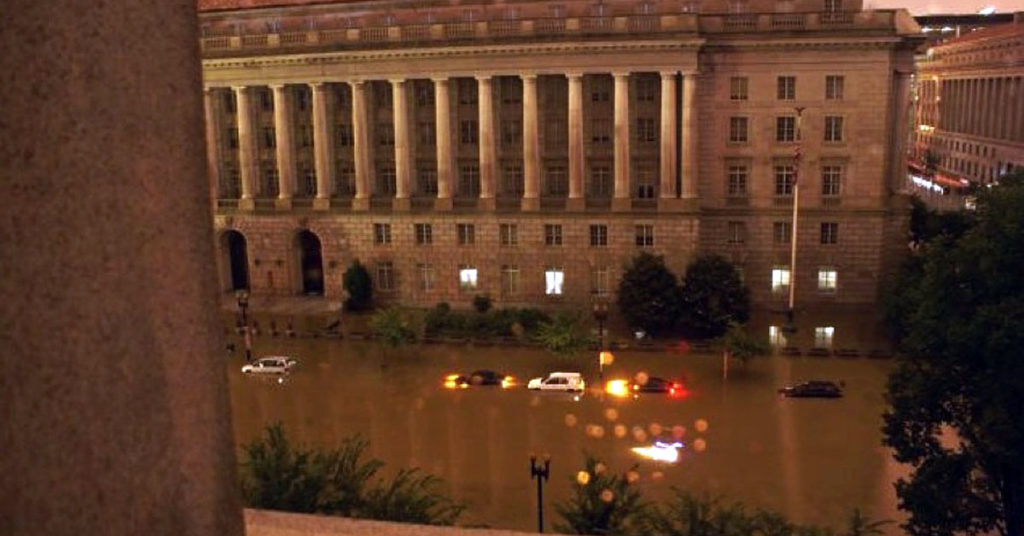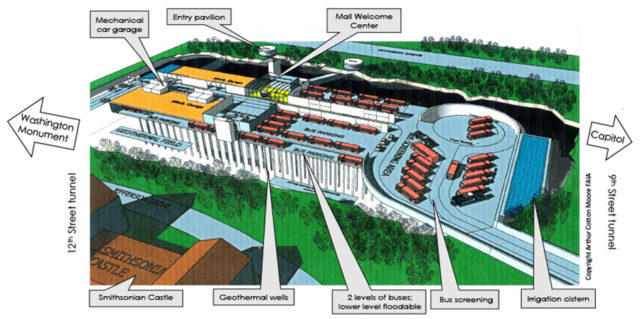Flood Control and Resilience with the National Mall Underground

In June 2006, heavy rains inundated Mall grounds, as well as adjacent museums, roads, businesses, and federal buildings, causing millions of dollars in damage to property and cultural resources. The National Archives remained closed for three weeks. Lesser storms in 2019 and 2020 flooded Mall-area streets and government building basements. According to meteorologists and climate scientists, the flooding threat is real and growing. But government has been slow to respond and find ways to protect our national treasures on the Mall.

One solution provides flood control and more. A truly innovative, comprehensive, public-private approach to Mall planning, the National Mall Underground consolidates in one multi-purpose facility the needs of all constituencies – local residents, Mall visitors, Smithsonian, National Park Service, District of Columbia government, Architect of the Capitol, General Services Administration, and others. The Underground will solve longstanding stormwater flooding problems, provide renewal clean energy to the buildings around the National Mall, and create a more welcoming, lively, and resilient Mall in the heart of the nation’s capital.
As the diagram above shows, the National Mall Underground is a multi-purpose flood protection and parking facility that also provides a much-needed Mall Welcome Center with restrooms and food options. During heavy storms, tour buses will be removed from the lower story to allow flood waters to flow into this area until they can be pumped out later into the sewer system.
A field of geothermal wells will provide 3,000 tons per hour of renewable energy to Mall-area museums and government buildings.
This multi-function approach allows the National Mall Underground to use multiple revenue sources — including parking fees and stormwater and clean energy tax credits — to finance more than two-thirds of the cost of a stand-alone flood detention facility. The cost is estimated to be between $260 and $320 million.

The project has been developed since 2011 by the National Mall Coalition in partnership with local philanthropist and businessman Albert H. Small and renowned architect Arthur Cotton Moore FAIA, and in consultation with federal and District of Columbia agencies, as well as engineering, parking, security, and sustainability experts.
[Visit the dedicated National Mall Underground website here.]
UPDATE October 21, 2021: Coalition presents the Underground concept to the U.S. Commission of Fine Arts. Read more and watch a recording of the 15-minute presentation here.
UPDATE August 22, 2021: In response to the DC Silver Jackets interagency flood response team’s 2020 report that supports a stormwater cistern beneath the Mall — but without car parking — the Coalition has developed “Alternative A” that includes no cars.
August 21, 2020 UPDATE: Finance Plan Supports Feasibility of National Mall Underground.
June 22, 2020 UPDATE: The National Mall Coalition’s June 3rd presentation turned out to be “Architecture Month’s biggest event.”
June 1, 2020 UPDATE: Please join us for a webinar on flood resiliency on June 3, 2020
July 9, 2019 UPDATE: Heavy rains once again caused Mall-area stormwater or “interior” flooding. Read more here and here.
September 18, 2018 UPDATE: The Army Corps of Engineers has completed its review of the National Mall Underground. Read more.
Who benefits and how?
- The Federal government: The storm water reservoir is able to collect 30 million gallons of floodwater to protect Smithsonian museums and federal and DC government buildings from the kind of flooding that devastated the Federal Triangle and Mall area in 2006* Geothermal wells will provide clean heating and cooling to nearby museums and government buildings.
- District of Columbia government and residents: Parking will be provided for up to 600 tour buses (in the revised 2020 design) to relieve congestion and reduce significant pollution from circling and idling buses on city streets*
- Mall Visitors: Parking for 700 cars and welcome center with public amenities will improve access, increase the Mall’s vitality into the evening hours, and connect visitors to local cultural life*
- Mall Area Museums and Gardens: Irrigation cisterns and geothermal cooling capacity will increase Mall sustainability, reduce the energy footprint, and conserve valuable resources for the National Park Service, Smithsonian, and public buildings*
- Emergency Service Providers: Mall Shelter Station will enhance security and public safety during large public events such as the inauguration and provide Mall visitors with shelter during emergencies
*Parking fees and water and clean energy tax credits make this a largely self-funding facility, according to financial analyses conducted in 2019
Why the multi-purpose Underground now?


In response to the 200-year flood that devastated Mall-area museums in 2006, 14 Federal and District agencies completed a report that predicted stormwater flooding will increase and intensive in coming years (click at left to read the 2011 report), concluding that one solution was to construct cisterns under the Mall. But the report was put on the shelf because no government entity took responsibility to act on the recommendations.
We saw this data-based study’s findings and recommendations as an exciting opportunity to both solve the flooding problem as well as serve other needs of all Mall constituencies that were not being addressed by government planners. Learn more at this dedicated National Mall Underground website.
Read coverage in the media here. Learn more about Mall flooding history under Resources–Research.
What are the precedents?


The Dutch have taken the lead in solving flooding problems with innovative, multi-purpose solutions that provide additional benefits, namely parking.
Major cities and tourist destinations in the US as well as around the world have constructed underground parking for cars and buses that provide convenient visitor access while also reducing traffic congestion and air pollution on city streets, e.g., Boston Common, Washington National Cathedral, Amsterdam’s Museumplein, Chartres Cathedral, and Vatican City. Review examples of innovative parking facilities here.
Why a collaborative effort?
The National Mall Underground requires collaboration because there are myriad problems facing the National Mall that, due to fragmented jurisdictions – including Smithsonian, National Park Service, GSA, Architect of the Capitol –, cannot be addressed by any single current planning entity.
We had over 200 meetings and working sessions that brought together people from a variety of stakeholders — from the White House to District of Columbia government, and the Smithsonian to the American Institute of Architects — to expand the scope of the project so it could solve a host of problems efficiently.

We created a year-long National Mall Underground exhibition in Downtown DC, with a speaker series, to further draw input from local residents, members of the business community, and tourists.
Such intense, sustained collaboration has capitalized on innovative thinking while leveraging the limited resources of individual agencies to solve problems that otherwise appear insurmountable.
What kind of expert analysis has been done?

In addition to collaborating with federal and DC stakeholders on developing the design concept, we have consulted a host of federal and DC studies — flooding and flood control, tour bus parking, water resource management, transportation, and visitor needs. We also commissioned supplemental studies including engineering, parking demand, geothermal, and cost benefit analyses. We have made all this data available to federal and DC entities.
What’s next?
In May 2017, the Council of the District of Columbia unanimously approved a Resolution asking the U.S. Army Corps of Engineers to undertake a “technical review” of the National Mall Underground project. Watch the Coalition’s presentation to the D.C. Council in the video below.
The Army Corps’ team of engineers and planners began their review in January 2018 and completed their favorable report in September 2018. Read the Corps’ report here.
Also in September 2018, we were invited to present the Underground concept to a multi-agency, inter-governmental flood team, the DC Silver Jackets. Read more here.
On June 3, 2020 we presented the National Mall Underground concept in a webinar sponsored by the DC Chapter of the American Institute of Architects for Architecture Month 2020. Watch the presentation and a shortened 17-minute edit here.
On October 21, 2021 the Coalition was invited to present the Underground concept to the U.S. Commission of Fine Arts. Read more here.
Ultimately, Congress will need to take action to authorize final development and implementation of the Underground.
CLICK ON THE PRESENTATION BELOW to review an in-depth review of the Mall needs and the Underground solutions:


